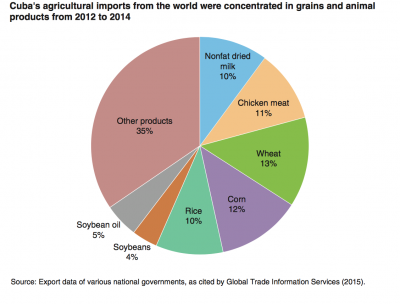China has bought at least 8 million tons of US soybeans this year, according to people familiar with the matter, putting the world’s top importer on track to meet a…
Cuba Agricultural Trade Issues
Frank E. Lockwood reported on the front page of the Arkansas Democrat Gazette on January 2nd that, “A congressman from northeast Arkansas will reintroduce legislation to ease trade restrictions with Cuba, and says he’s hopeful that barriers to agricultural sales will be addressed early in 2017.
“But there’s plenty of uncertainty after the Nov. 8 presidential election and the Nov. 25 death of Fidel Castro, the 90-year-old former Cuban president.
“It’s unclear whether President-elect Donald Trump would be willing to support the bill, which is sponsored by U.S. Rep. Rick Crawford, a Republican from Jonesboro.”
The Democrat Gazette article noted that:
The federal government currently bars farmers from extending credit to Cuban purchasers. As a result, Cubans must provide ‘cash in advance‘ whenever they purchase U.S. agricultural products. Crawford’s legislation would allow credit to be extended, a change favored by many of the state’s farm groups.
Mr. Lockwood pointed out that, “But America shouldn’t surrender the Cuban market to communist competitors from China and elsewhere, [Rep. Crawford] said.
“‘We can play a positive role there, fill that void, give them a cheaper, safer more readily available food supply or we can continue to view this through the lens of the Cold War and allow them to continue down that communist road that doesn’t work for anybody,’ he said.”

The Democrat Gazette item added that, “U.S. Sen. John Boozman, who has co-sponsored legislation to ease trade restrictions with Cuba, said he remains hopeful that barriers to agricultural sales can be removed in 2017.”
Meanwhile, a 2015 paper from the U.S. Department of Agriculture’s Economic Research Service (ERS) stated that, “Past levels of U.S.-Cuba agricultural trade suggest the possible size and composition of future trade flows between the two countries. Before the Cuban Revolution, the United States and Cuba were major agricultural trading partners. During fiscal years (FY) 1956-58,2 Cuba was the ninth leading destination for U.S. agricultural exports and the second leading supplier of U.S. agricultural imports. U.S. agricultural exports to Cuba averaged $139 million per year during this period…At current prices (calendar years 2012-14), U.S. agricultural exports to Cuba during FY 1956-58 would amount to roughly $600 million annually…”
The ERS report noted that, “Rice, lard, pork, and wheat flour were the four leading U.S. agricultural exports to Cuba in terms of value during FY 1956-58. Cuba was typically the largest commercial market for U.S. long-grain rice exports prior to the embargo, often taking more than half of U.S. annual long-grain sales and almost one-third of total U.S. rice exports.
If Cuba imported the same amount of rice today as it did then, it would be the 7th leading destination for U.S. rice exports, even though Cuba’s annual per capita rice consumption was about two-thirds of what it is today.
Also, the ERS report pointed out that, “In October 2000, the Trade Sanctions Reform and Export Enhancement Act (TSRA)—which authorized certain sales of food, medicines, and medical equipment to a number of countries, including Cuba—was signed into law…TSRA’s exemptions to the embargo quickly led to the reestablishment of U.S. agricultural exports to Cuba.”

With respect to agricultural competitors trading with Cuba, the ERS report explained that, “The United States is not Cuba’s only foreign supplier of agricultural products. Export data reported by Cuba’s trading partners indicate that Cuba’s agricultural imports from all countries averaged $1.8 billion per year during 2012-14. The United States was Cuba’s second leading supplier of agricultural imports during this period ($362 million), while the European Union (EU) ($383 million) and Brazil ($348 million) were Cuba’s first and third leading suppliers.”

And in more detail on what specific commodities Cuba was importing, the ERS report explained that, “Cuba’s agricultural imports are concentrated in grains and animal products. During 2012-14, the five leading agricultural imports in terms of value were wheat (13 percent), corn (12 percent), chicken meat (11 percent), nonfat dried milk (10 percent), and rice (10 percent).

Lower commodity prices and decreasing farm incomes could bring added political pressure on lawmakers to expand trade opportunities for agricultural producers. However, incoming executive branch officials may have different priorities when it comes to U.S. trade policy.





